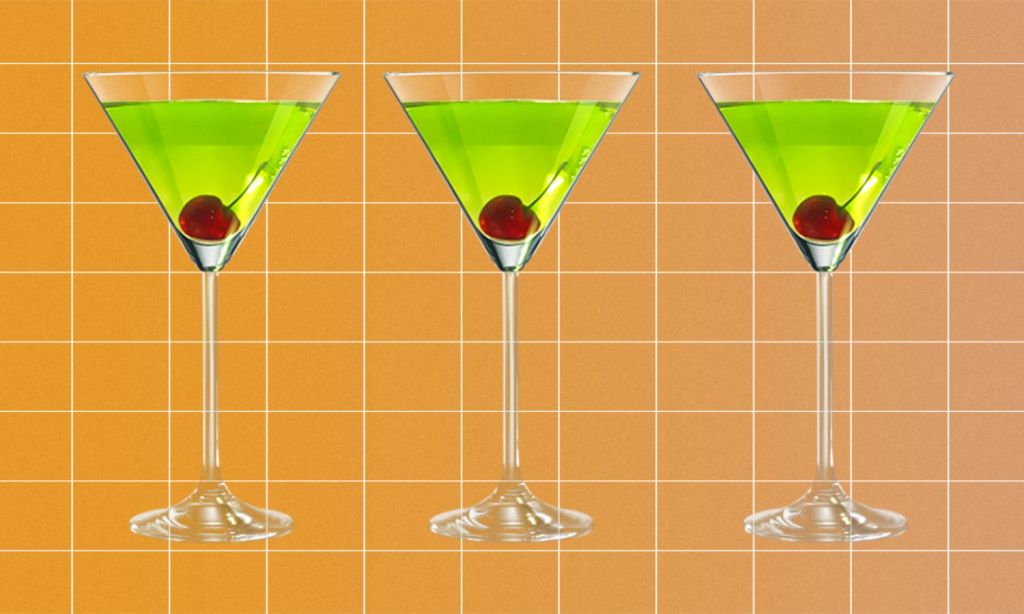Though the Japanese Slipper cocktail looks brat-coded, it was invented long before Charli XCX was born. Frenchman Jean-Paul Bourguignon created it at the now-closed Mietta’s Restaurant in Melbourne in 1984 (Charli was born in 1992). The drink didn’t take off then, but it’s now having a revival, becoming more popular than ever.
The drink is made with Midori, Cointreau, lemon juice and often a cherry, garnished with a slice of honeydew melon. Bourguignon came up with it while writing the cocktail menu for Mietta’s, reports Punch.
A sales rep had brought him a bottle of Midori to try so he mixed the melon liqueur with Cointreau from his native France and added lemon to balance the sweetness. When Bourguignon went on to work at resorts, casinos, airlines and hotels around Australia, he put the Japanese Slipper on their cocktail menus. The drink spread quickly.
“But, like many drinks of the 1970s and ‘80s, the Japanese Slipper has been through a period of staunch dismissal, shrugged off as bright-green rocket fuel better left at 21st birthday parties,” explained Punch writer Fred Siggins in 2020.
Fast forward to this year and Siggins has again penned a piece about the drink, writing that he’s been seeing a steady revival of it, in various guises, at some of Australia’s best bars, including Above Board, Bar Liberty, Jangling Jack’s, Dulcie’s and Huelo.
Remy Wise-Petering, bar manager of QT Perth, says he appreciates its simplicity and thinks it’s a great template to advocate for three-ingredient drinks. “I’m not normally a fan of melon liqueurs as I find them too sweet and artificial but when balanced correctly in a Japanese Slipper, I can get around it for sure,” he says.
While Chris Gaweda, QT Melbourne’s bar manager, says he wouldn’t order a Japanese Slipper himself, when he makes them for guests and taste tests it, he’s always struck by how refreshing they are — a vibrant hit on the palate. Gaweda says they’re typically ordered by guests who appreciate a classic, feminine cocktail.
“The bright green colour, while fitting the retro vibe, may have been its downfall, appearing somewhat artificial,” he says. “It wasn’t well understood either — people perceived it as overly sweet and it was considered a bit of a daggy drink at the time.”
Melon liqueur is also hard to sell to a wider market as its potent flavour doesn’t appeal to everyone, add Wise-Petering. The Japanese Slipper serves it well, with its citrus allowing the bold melon notes to shine while cutting some of the overpowering sweetness.
“Some big melon brand liqueurs carry a reputation for being ‘cheap’ and ‘low quality’ so this will turn some people, but after seeing them incorporated into cocktails, most famously the Japanese Slipper, they were perceived more fondly,” says Wise-Petering.
Gaweda says the Japanese Slipper’s revival is part of the movement towards retro — retro fashion, music, design and drinks, including cocktails Cosmopolitan and Pina Colada. People are gravitating towards fun, less serious cocktails and Midori, the key ingredient in a Japanese Slipper, is now popular again.
“We are seeing more trends from the ‘80s and ‘90s making a revival nowadays to bring back bright, bold and colourful creations and the high energy and carefree fun accompanying them,” says Wise-Petering.
Another drink trend the cocktail taps is a focus on simpler flavours and letting hero spirits shine. Three-ingredient cocktails are sleek but also easy for everyone to make from home.
Atsuko Asano, general manager of Bar Morris, says he thinks the Japanese Slipper wasn’t popular at the start partly because its name didn’t give away too much about it. But like fashion, old drinks become new again. Also today, more Cointreau-like spirits are available so bartenders can put modern twists on the original. “Plus, new garnishes are giving it an updated look and feel,” she says.
Another way bartenders are modernising the Japanese Slipper is by adding bitters and syrups to complement the melon notes. An example is adding a nutty note with orgeat or nut-forward bitters.
“Share-style drinks are also becoming a big staple for every bar, like jugs and bowls of cocktails for a group to share,” says Wise-Petering. “So elongated and effervescent style versions of this drink are also becoming popular.”
“The Japanese Slipper will always be the most recognisable and famous cocktail adaption for melon liqueur,” he says. “But I think the liqueur will be used in more unexpected ways that will not follow the same intensity as the Japanese Slipper.”
Related: You Could Soon Find More Than Olives and Onions in Your Cocktails
Related: Fermentation Is Coming for Our Cocktails
Read more stories from The Latch and subscribe to our email newsletter.

